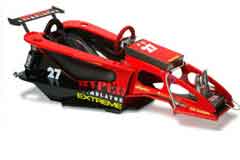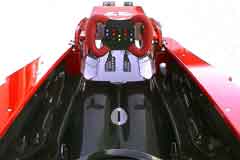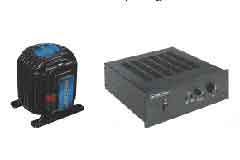Picture this: you come home from the office, change into a pair of driving shoes and climb into your very own racing simulator. Within a couple of clicks of the mouse, you're flying around the corners of Monaco in your Ferrari Formula One. Couple more clicks, and you're driving a CHAMP Car around Long Beach. Or an IRL car at Indy. Or a Cup Car at Daytona.

Stop pinching yourself - you're not dreaming. You can actually have your own personal simulator. Put it together correctly, and your simulator-induced adrenaline rush will feel like the real thing. Today's technology allows you to surround yourself in the track and feel the tires roll over the tarmac. What makes this a simulation instead of a computer game is complete immersion in the environment. It's a thrill for nearly all of your senses: not only visual, but also sound, vibration and, as much as possible, motion. Smell is one that hasn’t been managed yet (but you could come close if you invited over a few hairy french chicks to watch you drive the Magny-Cours track). It's all within your reach - but only if you do it right.
The first thing you need to decide is what type of racing you wish to compete in. There are games for NASCAR, Sports Cars, Formula One, Indy, Drag … you name it.
All of these games and simulation software make for a realistic simulation with varying degrees of accuracy. Most offer some kind of full season championship. Some offer schools on how to drive the tracks and on race strategy. They are programmed with the rules and the cars in their liveries for the different series and seasons. The weather conditions change, as well. As your skill levels advance, you can adjust things like spring rates, gearing ratios and aerodynamics. Once you have decided what you want to race and have modified it to your liking, you need to decide how you are going to race it: on a PC, or a game console like Xbox or PlayStation2.
With some of these, you can compete online. We were on E.A.’s NASCAR Thunder website (easports.com/games/thunder2004/home.jsp), and there were over 5,500 Playstation2 gamers online at the time. While game consoles may have more titles available and it may be convenient to just plug it into your entertainment system, we recommend going with a PC-based simulation software.
The reason for this is the ability to upgrade and improve the simulation with ad-ons and modifications. We'll get to that later, but they keep the simulation fresh, current, and a lot more realistic and fun. Though you’re less likely to be able to play online against other racers with a PC-based simulator, there are very active groups of modders making new car sets and drawing tracks all the time, so there's always something new to play with.

Next you will need a steering wheel, cockpit and “car." What you buy will depend on whether you go PC or game console. Our simulator car is a Hyperstimulator (www.hyperstimulator.com). It’s a complete Formula One cockpit, which allows for serious racing realism. Hyperstimulator features a Formula One-style butterfly steering wheel with paddle shifters, programmable buttons and a carbon fiber seat. Many options are available, such as a harness, water bottle and pit wheels for moving the cockpit around.
Hyperstimulator cars run in price from Clubman Kit, which can use third party wheels starting as low as $330 (plus shipping) without a wheel, to the full loaded, factory-built Extreme for $3,907.

Made in Australia, our Hypersimulator unit was a tradeshow demo for one of their former U.S. distributors. It’s pretty amazing - but since it's basically a large piece of furniture, you'll need to have somewhere to put it. You sit down in the racing seat with your body in the same position as a driver in contemporary Formula One car - your feet 100 millimeters higher than your rear end. You can adjust the wheel and the peddles for a perfect fit. The Hypersimulator is equipped with paddle shifters - easy to reach even in a tight turn - and a sequential stick shift, should you prefer a more traditional experience.
The Hyper's wide body version is the only one sold in the United States because of our ample midsections, but it is still a tight fit for most Americans. Those over six feet will have a very tight fit, but getting in out is made easier due to the hinged steering wheel housing, which can be released to make entry easier.
One drawback to the Hyperstimulator is the lack of force feedback in the steering wheel. The makers of the Hyper feel that the sampling rates aren’t fast or realistic enough, supporting that claim with the fact that many Formula One drivers use Hypers for practice.
We intend to try some force feedback wheels and find out if they are any good, so check back soon. A popular and inexpensive wheel is the Logitech MOMO Racing Wheel. Momo makes real wheels used in many racecars and other professional racing equipment, and their wheel features the allure of force feedback - which delivers the feel of resistance and bumps of racing. The full rubber wheel provides a comfortable grip and precise steering. There are paddle shifters, a la Formula One, which allow for fast gear changes with both hands on the wheel. The driver can also opt for the manual shift knob for sequential shifting. There are six programmable buttons to request pit stops and to check on the cars systems. There are 240 degrees of wheel rotation lock to lock, which is very similar to a contemporary racecar. More information on the Logitech MOMO Racing Wheel can be found at: www.logitech.com.
There are a many other steering wheels are available - as are seats and cockpits. Check back with us for reviews of those, too.

The Hyperstimulator comes with a shaker amp and speaker, but it’s mediocre at best, so we strongly recommend an upgraded shaker system. One of the best systems (and the one we’ve got installed in our Hyper) is the Buttkicker LFE Kit for the Hyperstimulator and most large cars like it.
The kit includes the Buttkicker LFE shaker transducer, the BKA 100-4 1100-watt amplifier, mounting kit and all the cables needed to hook it up.
The Buttkicker is a non-audible shaker speaker system - think of it as silent sense-around - and it adds a lot to the realism. And you can be sure it lives up to its name - you can feel every shift, curb and wall (if you crash like us).
You can use the chair/couch accessory mounting kit, or you can install the LFE transducer inside the Hyper. But to do that, you’ll have to take it apart and reassemble it, a process that’ll take about two hours.
For those who have a wheel on their desk, there is the Buttkicker Gamer with 150 watts. Just attach it to your chair and hold on. You can find more information at www.buttkicker.com.
Computer:
You'll need a fairly robust gaming PC with a specific sound card that has a second parallel port for the Hyper. If you are using a steering wheel such as the MOMO Logitech with a USB connection, this is not as important.
Since racing games tend to be short on low end, you want to make sure that you have a good sound card.
Rodney Gabriel over at Simulated Racing put together our computer, which includes:
- INTEL PENTIUM 4/2.8GHz/512K 533MHz SO C478PIN CPU
- 512MB/PC266/NON-ECC DDR DIMM MEMORY
- 40.9GB/7200RPM ULTRA DMA HDD
- Radeon 9800 SE 128Mb Video Card DDR W/ TV Out.
- CREATIVE LABE SB AUDIGY
- MS WINDOWS XP HOME EDITION
- 16X DVD BARE DRIVE /IDE/INT
- OFTWARE DVD (CYBERLINK POWER DVD)
The computer came complete with a host of games and a few of the mods we mentioned earlier. You can find Rodney at www.simulatedracing.com.
Software:
EA Sports F1 Career Challenge 1999-2002. This is the best Formula road racing simulation around. Out of production since 2003, it is hard to find, but we have seen it on EBay for around $100. Our pal Rodney includes it in his system.
The Grand Prix Challenge game has all the tracks, cars drivers and rules for the F1 seasons from 1999 to 2002. The game has a huge following worldwide, with many people doing mods for the program, including a German economist named Ralph Hummerich. He adds the seasons that have been run since the game went out of production. He updates the car sets, their liveries, and the rules for the seasons. We have the 2004 season, and it is a great update. It includes tracks that were not in the original game, such as Bahrain and Shanghai. The sound has also been improved to give the blip in the exhaust on downshifts. Visit Ralph for more information at www.sportplanet.com/emac/rh/.
The other popular Formula One games are Grand Prix 4 and Grand Prix Legends. Legends covers the 1967 Formula One Championship, and is very popular, particularly with purists. They also have very active mod and message board followings.
Another mod, which we haven’t tried yet, is from CARTMods.net. The mod for F1 Challenge covers the CART Champ Car seasons from 2000 to 2004. The great thing about it is that you can drive major tracks in the United States in an open wheel racecar. Choose from tracks like Mid Ohio, Long Beach, Road America, Toronto and more. We’re really anxious to try this one out, as it has tracks that we occasionally get to drive on in real life.
Another popular game we haven’t tried yet is GTR from the SimBin Development Team and publisher 10TACLE STUDIOS. The game covers the FIA GT Championship and has mostly European tracks, although there is U.S. style oval add-on pack available.
For you NASCAR fiends, Electronic Arts has released NASCAR Thunder. The game was last produced in 2004 and was developed by Image Space Incorporated, which also produced F1 Challenge.
If you want to race in the Indy 500, Codemasters publishes a game called IndyCar Series. A 2005 version is coming soon. Until then, check out www.codemasters.com/indycarseries/usa/indycarseries.php.

Sound:
What's the fun of a racing game if you can't hear the revs you're throwing off? The sound of the engine and squeal of the tires add to the sensation of speed. You want as high end a sound card as you can get. We have a Radeon 9800 SE 128Mb Video Card DDR W/ TV Out, which will cost you some additional cash. But remember that the higher you go, the better your racing experience. We were able to get the Logitech® Z-2300 2.1 speaker system at retail for around $150. The 2.1 means there are two high- and mid-frequency speaker cabinets with a 2.5 speaker, and a single subwoofer with an eight-inch speaker in a ported cabinet. The system has 400 watts of power and is THX rated - yes, the same THX you see and experience at the movie theater. THX certification is the ultimate mark of quality for speaker systems; it means speakers have been tested and approved by THX based upon a set of rigorous technical specifications. Few computer speaker systems meet these rigid standards. To learn more about THX, visit www.thx.com.
The Logitech® Z-2300 2.1 speaker system has plenty of power to replicate the volume and the sound of a Formula One engine. If you want to spend more money, you can get a 5.1 speaker system, with five speakers and the subwoofer, for the full surround sound experience. These are great, particularly if you are going to hook up all of your home entertainment gear to the same system.
The Z-2300 speakers are also great for dorm rooms - they've got enough power to drown out that poser with the big speakers in the room above you. You can find more information about Logitech speakers at www.logitech.com.
Our computer has a SoundBlaster SB AUDIGY card. Just keep in mind that racing games tend to be shy on low frequency info, so you want a card and speakers that are going to deliver as much of the audible range as possible.
When connecting your sound system to the computer, you are going to want to use a splitter cable so that you can feed the signal to both the Buttkicker and to your stereo speakers.
Video:
Cough up the dough for a good video card, because it's the most important part of your simulation experience. If you want to tell whether your current card can handle being used by a simulator, look at the car when it spins in F1 Challenge. If you see jagged edges, or the car breaks up, your current card won't cut it. The computer has a tough job recreating the rapidly changing scene of a racing simulation. The more robust the card, the more realistic - simple as that.
Our computer is equipped with a Radeon 9800 128Mb Video Card DDR W/ TV Out. If you do wind up with a HyperStimulator, you will need to make sure to get a card with a second joystick port. If you are using other wheels like the Logitech MOMO or others that use a USB connection, this is not a consideration.
The monitor and where you place it is another key part of the simulation. Rodney at Simulated Racing likes a 30-inch flat panel at his feet. We prefer a 20- to 23-inch flat screen sitting above the steering housing of the Hyper. For us, at least, this setup gives it a more realistic perspective. It is close enough to give the track more depth of field and perspective, with an almost peripheral view. So far, we have not had the opportunity to review any screens for this use. We hope we will shortly so we can make some recommendations.
Now that we have our system at home, we are going to start to explore some of the different games and other gear to see how realistic a simulation they provide.
I am trying to get in as much time as I can behind the wheel. Prior to every real Formula One race, I drive the simulated track on our Hyper, putting in an hour and a half or so on each track prior to the race. I need to get faster, but I am certain that will come with practice. And I need to refine my race skills - these sim drivers are very aggressive. They'll knock you off the track if you're not wary. We will be posting articles on them as we go so check back. See you on track.




